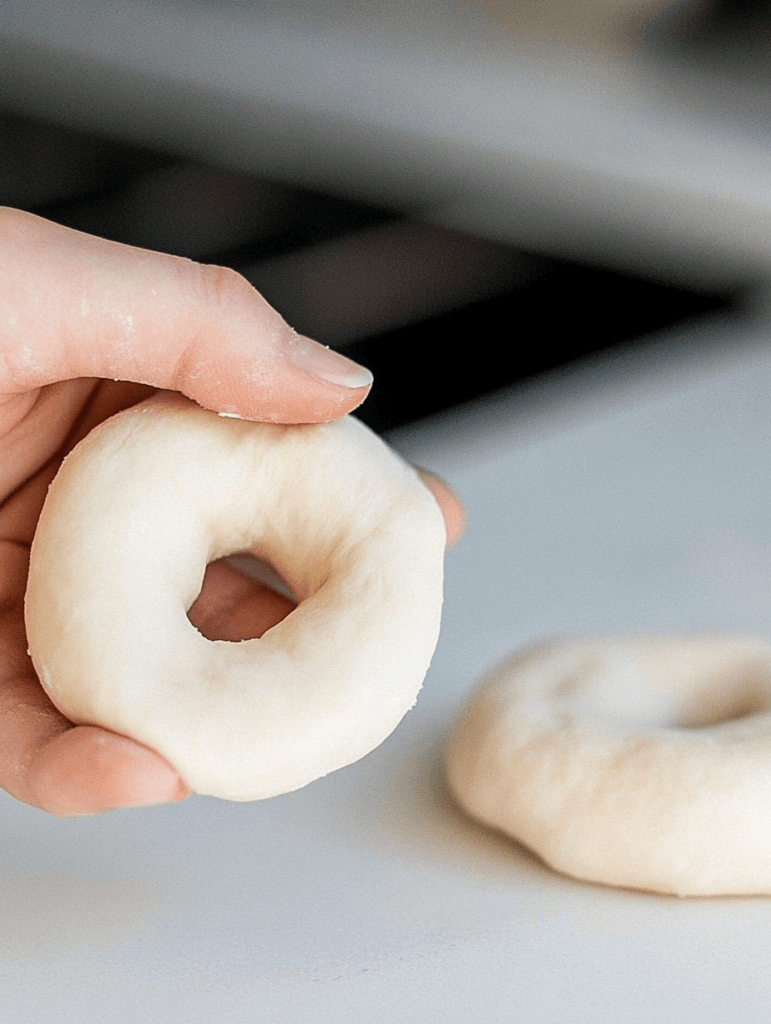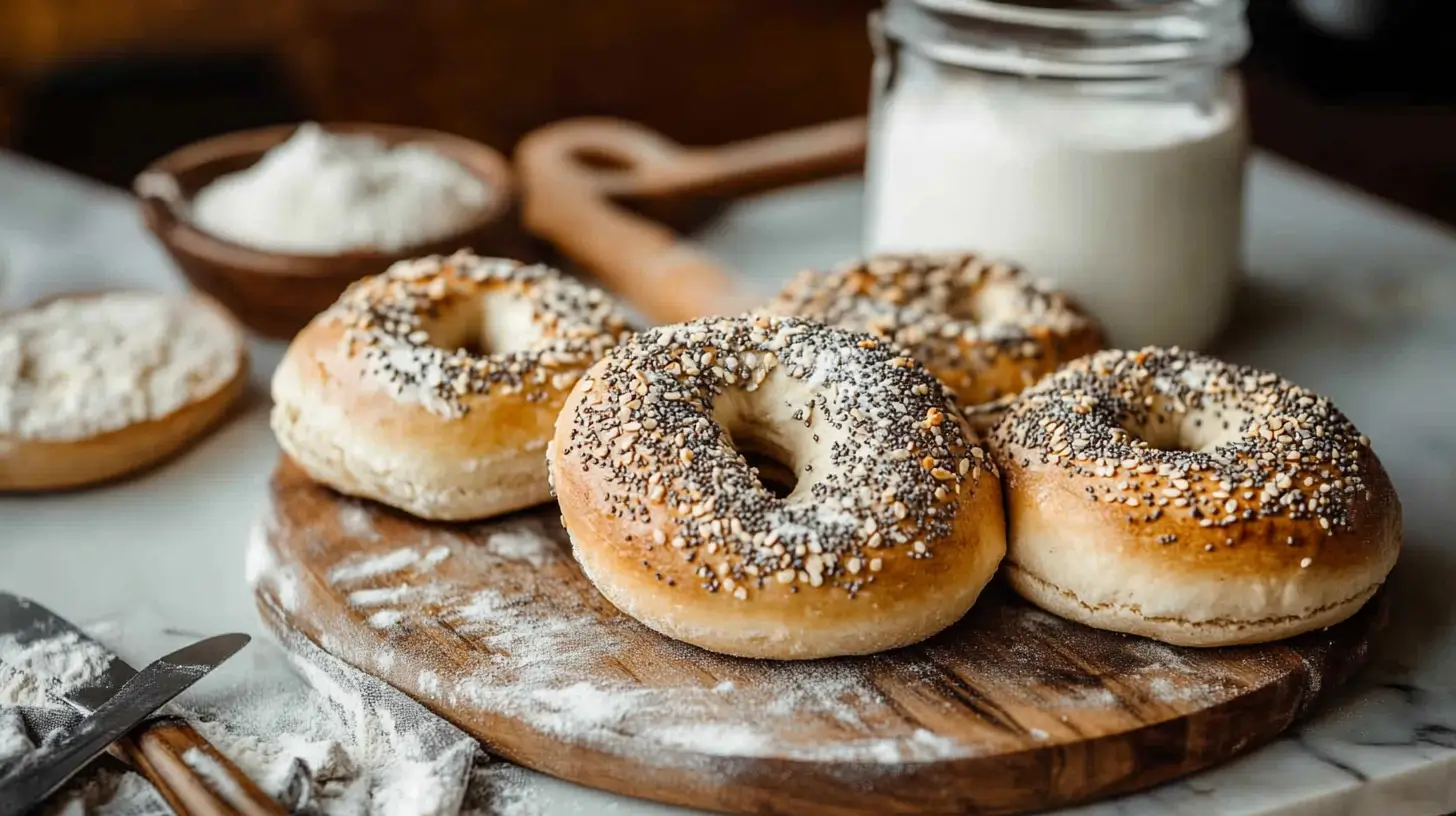Imagine biting into a freshly baked bagel with a perfectly chewy interior, a golden crust, and that signature tangy flavor only sourdough can deliver. Sounds irresistible, right? If you’ve ever wondered how to achieve bakery-style bagels in your own kitchen, you’re in for a treat. This sourdough bagel recipe combines the art of traditional baking with the modern convenience of easy-to-follow steps, giving you delicious results every time.
What sets sourdough bagels apart from their yeasted counterparts? It’s all about flavor and texture. Sourdough brings a depth of taste that’s impossible to replicate with commercial yeast, thanks to the natural fermentation process. Plus, sourdough bagels boast a unique chewiness and a crisp crust that elevate them to an entirely new level of bagel bliss.
In this guide, we’ll walk you through everything you need to know to master homemade sourdough bagels. From preparing your starter and mixing the dough to boiling and baking, every step is carefully detailed to ensure your success. You’ll also find tips for troubleshooting common issues, creative flavor variations, and the best ways to serve and store your bagels.
Ready to roll up your sleeves and create something truly special? Let’s dive into the world of sourdough bagels!
Table of contents
Essential Ingredients for Sourdough Bagels
To create the perfect sourdough bagels, it’s essential to start with high-quality ingredients. Each component plays a critical role in achieving that signature taste, texture, and structure. Here’s what you’ll need:
The Role of Sourdough Starter
The star of the show is your sourdough starter—a living culture of wild yeast and bacteria. For this recipe, make sure your starter is:
- Active and bubbly: Feed your starter 6–8 hours before you start baking to ensure it’s strong and ready to leaven the dough.
- Mature: A well-established starter (at least 1–2 weeks old) yields the best flavor and rise.
- Hydration level: Stick to a 100% hydration starter (equal parts water and flour by weight) for the best results.
Pro Tip: If your starter isn’t active enough, let it rest in a warm place for a few hours after feeding to boost its activity.
Flour: The Foundation of Great Bagels
The type of flour you use can significantly impact the outcome. Here are your options:
- Bread flour: High in protein (12–14%), this flour gives bagels their chewy texture. It’s the best choice for a classic bagel experience.
- All-purpose flour: Works in a pinch but may result in slightly softer bagels.
- Whole wheat flour: Adds a nutty flavor and a denser texture. You can replace up to 50% of bread flour with whole wheat for a healthier twist.
Pro Tip: Avoid cake flour or low-protein flours, as they don’t provide enough gluten for proper bagel structure.
Water: The Unseen Hero
Water binds all the ingredients together and plays a key role in the fermentation process. Use filtered or spring water to avoid chlorine, which can inhibit the activity of your sourdough starter.
Salt: The Flavor Enhancer
Salt is essential for balancing flavors and strengthening gluten structure. Use fine sea salt or kosher salt for even distribution. Avoid iodized table salt, as it can leave an aftertaste.
Sweetener: For Taste and Fermentation
Traditional bagel recipes often call for a touch of sweetness to enhance the flavor and support fermentation. Common options include:
- Honey: Adds a subtle floral sweetness.
- Molasses: Perfect for darker, richer bagels.
- Brown sugar: A versatile option with mild sweetness.
Pro Tip: Avoid overloading the dough with sweetener, as it can slow down fermentation.
Optional Add-ins and Toppings
Customize your sourdough bagels with these popular options:
- Seeds: Sesame, poppy, or sunflower seeds for crunch.
- Spices: Garlic powder, onion flakes, or everything bagel seasoning for bold flavors.
- Dried fruit: Raisins, cranberries, or blueberries for sweet variations.

Tools and Equipment You’ll Need
Making sourdough bagels at home is a rewarding process, but having the right tools can make it much easier and more enjoyable. While you don’t need a fully equipped bakery to get started, investing in a few key items will ensure your bagels turn out perfectly every time.
Baking Essentials
These are the must-have tools for creating sourdough bagels:
- Mixing Bowls:
- Use medium and large bowls for mixing and proofing the dough.
- Opt for glass or stainless steel bowls to monitor the rise more easily.
- Kitchen Scale:
- Precise measurements are crucial in sourdough baking. A digital scale helps you weigh ingredients accurately, ensuring consistent results.
- Dough Scraper:
- This handy tool makes it easy to handle sticky dough and divide it into even portions for shaping.
- Baking Sheet or Tray:
- A sturdy baking sheet is essential for holding your bagels during proofing and baking.
- Line it with parchment paper to prevent sticking.
- Plastic Wrap or Damp Towel:
- These are used to cover your dough during proofing to prevent it from drying out.
- Pot for Boiling:
- You’ll need a large pot for boiling the bagels before baking. This step gives bagels their signature chewy texture.
Optional Tools for Perfect Bagels
For the avid baker, these tools can take your bagels to the next level:
- Proofing Baskets (Bannetons):
- Ideal for shaping and supporting dough during the final proofing stage.
- Baking Stone or Steel:
- Using a baking stone or steel helps retain heat, giving bagels a crispier crust. Preheat it in the oven for the best results.
- Slotted Spoon or Spider Strainer:
- Makes it easy to lift bagels out of the boiling water without damaging their shape.
- Stand Mixer (Optional):
- While sourdough dough can be mixed by hand, a stand mixer with a dough hook attachment can save time and effort.
- Cooling Rack:
- Place freshly baked bagels on a cooling rack to prevent sogginess from steam.
Why the Right Tools Matter
While you can technically make bagels with just a mixing bowl and your hands, investing in a few essential tools will improve your workflow and the overall quality of your bagels. Tools like a kitchen scale ensure accuracy, while a baking stone or steel can create bakery-quality results right at home.
With all the tools and ingredients ready, you’re set to begin the hands-on part of this sourdough adventure!
Step-by-Step Sourdough Bagel Recipe
Now that you have your ingredients and tools ready, it’s time to create your sourdough bagels. Follow these steps carefully to achieve the perfect chewy texture, golden crust, and signature sourdough tang.
1: Preparing the Sourdough Starter
A strong, active sourdough starter is the foundation of this recipe. Here’s how to prepare it:
- Feed Your Starter:
- Take 50g of your sourdough starter and mix it with 50g of flour (bread or all-purpose) and 50g of water.
- Stir well and let it sit at room temperature until it doubles in size and becomes bubbly (this usually takes 6–8 hours).
- Check for Activity:
- Perform the float test: Drop a small spoonful of starter into a bowl of water. If it floats, it’s ready to use.
Pro Tip: If your starter isn’t active enough, give it another feeding and allow more time for it to mature.
2: Mixing the Dough
- Combine Ingredients:
- In a large mixing bowl, add:
- 500g bread flour
- 250g water
- 100g active sourdough starter
- 10g salt
- 20g sweetener (honey, brown sugar, or molasses)
- Mix until the ingredients are just combined into a rough dough.
- In a large mixing bowl, add:
- Knead the Dough:
- Transfer the dough to a clean surface and knead for about 8–10 minutes until it becomes smooth and elastic.
- If you’re using a stand mixer, knead on medium speed for 5–6 minutes with a dough hook.
- Adjust Hydration:
- If the dough feels too dry, add a few drops of water at a time. If it’s too sticky, sprinkle in a little extra flour.
Pro Tip: Proper kneading develops the gluten, giving your bagels their characteristic chewiness.
3: Bulk Fermentation
- First Rise:
- Place the dough in a lightly oiled bowl and cover it with plastic wrap or a damp towel.
- Let it rest at room temperature for 4–6 hours, or until it rises by about 50%.
- Cold Fermentation (Optional):
- For enhanced flavor, transfer the dough to the refrigerator and let it ferment overnight (8–12 hours).
Pro Tip: Longer fermentation develops deeper sourdough flavor. However, room temperature proofing works if you’re short on time.
4: Shaping the Bagels
- Divide the Dough:
- Turn the dough onto a lightly floured surface and divide it into 8 equal portions (approximately 100g each).
- Shape the Bagels:
- Roll each portion into a smooth ball.
- Using your thumb, poke a hole in the center of each ball and gently stretch it to form a bagel shape. Aim for a 1–2-inch hole in the center.
Pro Tip: The hole will shrink during proofing and baking, so don’t worry if it seems too large at first.
5: Proofing the Dough
- Second Rise:
- Place the shaped bagels on a parchment-lined baking sheet. Cover them with a damp towel.
- Let them proof for 1–2 hours at room temperature, or until they appear slightly puffy but not doubled in size.
- Refrigerate (Optional):
- For better texture and flavor, refrigerate the shaped bagels for another 8–12 hours before boiling and baking.
6: Boiling the Bagels
Boiling the bagels before baking is what gives them their chewy texture and glossy finish. Here’s how to do it right:
- Prepare the Water Bath:
- Fill a large pot with water and bring it to a gentle boil.
- Add 1 tablespoon of baking soda to the water. This helps enhance the golden-brown crust during baking.
- Optional: Add 1–2 tablespoons of honey or malt syrup for a subtly sweet, bakery-style flavor.
- Boil the Bagels:
- Gently drop 2–3 bagels at a time into the boiling water. Avoid overcrowding the pot.
- Boil for 30 seconds on one side, then flip and boil for another 30 seconds on the other side.
- For chewier bagels, boil for 1 minute per side.
- Remove and Drain:
- Use a slotted spoon or spider strainer to lift the bagels out of the water.
- Place them on a wire rack or parchment-lined baking sheet to drain excess water.
Pro Tip: Boiling is what gives bagels their shiny crust, so don’t skip this step. Adding baking soda also creates a more robust chewiness.
7: Baking the Bagels
Now it’s time to transform those boiled bagels into golden, delicious perfection.
- Preheat the Oven:
- Preheat your oven to 220°C (425°F).
- If using a baking stone or steel, place it in the oven while preheating to retain heat.
- Add Toppings (Optional):
- While the bagels are still wet from boiling, sprinkle them with your desired toppings. Popular options include:
- Sesame seeds
- Poppy seeds
- Everything bagel seasoning
- Coarse salt or garlic flakes
- While the bagels are still wet from boiling, sprinkle them with your desired toppings. Popular options include:
- Bake the Bagels:
- Transfer the bagels to a parchment-lined baking sheet or directly onto the preheated baking stone.
- Bake for 20–25 minutes, or until the bagels are golden brown and firm to the touch.
- Cool the Bagels:
- Remove the bagels from the oven and let them cool on a wire rack for at least 10 minutes before slicing.
Pro Tip: For extra-crispy crusts, bake the bagels with steam. Place a small pan of hot water in the oven during baking.
Enjoy Your Homemade Sourdough Bagels!
Your sourdough bagels are now ready to enjoy. Slice them open, toast if desired, and spread with cream cheese, butter, or your favorite toppings. The chewy texture, golden crust, and tangy flavor will make all the effort worthwhile.

Tips for Perfect Sourdough Bagels
- If your bagels turn out flat, check out Why Are My Sourdough Bagels Flat? for troubleshooting tips.
- Wondering if sourdough bagels are a better breakfast option? Read Are Sourdough Bagels a Healthier Breakfast Choice? for insights.
- Curious about the anti-inflammatory benefits of sourdough? Learn more in Is Sourdough Anti-Inflammatory?.
- Proper storage is key to maintaining freshness. See How Long Does Sourdough Bread Last? for storage tips.
FAQs About Sourdough Bagel Recipe
Here are answers to some common questions about sourdough bagels, providing helpful tips and insights for bakers of all levels.
How long does sourdough bread last?
Sourdough bread generally lasts longer than regular bread due to its natural fermentation process. When stored properly, it can stay fresh for 4–5 days at room temperature. If you refrigerate it, the bread can last up to a week but may lose some of its texture. Freezing sourdough bread can extend its life for up to three months.
Is sourdough anti-inflammatory?
Yes, sourdough bread can have anti-inflammatory properties. Its fermentation process helps break down gluten and phytic acid, making it easier to digest and potentially reducing inflammation in the gut. Moreover, sourdough contains probiotics and prebiotics that support a healthy gut microbiome, which is linked to reduced inflammation.
Are sourdough bagels healthy?
Sourdough bagels can be a healthier alternative to regular bagels. They are easier to digest due to their fermentation process and may have a lower glycemic index, which helps maintain stable blood sugar levels. Additionally, they contain beneficial bacteria and nutrients, but like all baked goods, they should be consumed in moderation.
Can I put sourdough bagel dough in the fridge?
Yes, sourdough bagel dough can be refrigerated. In fact, many bakers prefer to cold ferment the dough for 12–24 hours to enhance its flavor and improve the texture. Make sure to cover it tightly to prevent it from drying out.
Are bagels healthier than ice cream?
It depends on the portion size and nutritional content. A typical bagel has more carbohydrates and calories than a serving of ice cream but contains little to no fat. Ice cream, on the other hand, is higher in sugar and fat. Both can be part of a balanced diet when eaten in moderation.
What do you eat with sourdough bagels?
Sourdough bagels pair well with a variety of toppings and spreads. Common options include cream cheese, avocado, smoked salmon, hummus, or nut butter. You can also enjoy them with sweet toppings like jam or honey, or use them as the base for breakfast sandwiches.
What’s the difference between sourdough bagels and regular bagels?
The main difference lies in the fermentation process. Sourdough bagels are made with a natural sourdough starter instead of commercial yeast, which gives them a tangy flavor and makes them easier to digest. They may also have a denser texture compared to regular bagels. Additionally, sourdough bagels often contain more beneficial nutrients due to the fermentation process.
Conclusion
Homemade sourdough bagels are a delicious and rewarding bake, perfect for breakfast or a hearty snack. Whether you enjoy them with cream cheese, smoked salmon, or as a sandwich base, they bring a delightful chewiness and depth of flavor.
For a sweet and savory twist, consider pairing your fresh bagels with Chicken and Waffles for a comforting and indulgent meal. Enjoy your baking! 🍞✨

